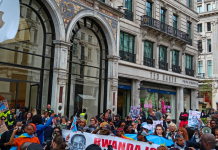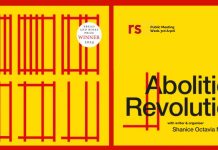Melissa Moreano Venegas looks at Sunday’s presidential election in Ecuador through the lens of Thea Riofrancos’ recent analysis of extractivism and its opponents.

Thea Riofrancos, Resource Radicals: From Petro-Nationalism to Post-Extractivism in Ecuador (Durham, North Carolina: Duke University Press, 2020) 264pp, $26.95
***
On February 7 Ecuador will elect as its new president one of three candidates: the banker Guillermo Lasso, who represents traditional right-wing parties; the young economist Andrés Arauz, of former president Rafael Correa’s political movement and part of the so-called Latin American ‘pink tide’; or Yaku Pérez, candidate of the Indigenous party. These elections are historic for three reasons:
1) The COVID-19 health crisis has been managed with negligence and corruption. As in most countries, the pandemic has revealed the deep contempt of elites for the working class, whom they consider disposable and replaceable. As of December 2020, Ecuador had around 40,000 excess deaths (by comparison, the UK had around 80,000 excess deaths but with four times the population). One corruption scandal followed the next; the most recent affront to the Ecuadorian people was the promise to acquire 4 million vaccine shots, after which only 4,000 arrived. The vaccination campaign is being undertaken in secrecy, amidst revulsion that the minister of health and his family were the first to get the vaccine, before the doctors on the front line.
2) For the first time in the history of this profoundly racist country a candidate from the powerful Ecuadorian Indigenous movement (organised around the Indigenous organisation CONAIE and its political arm, Pachakutik), have a very good chance of winning the presidency. This shift in Ecuadorian politics is a response to the success of the National Uprising of October 2019, an Indigenous and popular demonstration that saw 11 days of blockades, marches, and physical confrontation with the police and the military across the country. The Uprising was violently repressed and ended with 11 people shot dead by the armed forces, more than 1,200 injured and many Indigenous leaders criminalised. [1] But the Uprising also ended with a round of negotiations broadcast live on television and social networks in which, for two hours, Indigenous leaders negotiated with ministers on equal terms on behalf of the entire Ecuadorian population and in front of a mass audience many of whom had been used to viewing Indigenous people as ignorant quasi-citizens. Although Yaku Pérez was not a leading figure of the Uprising, his candidacy has benefited from this new view of Indigenous politics. His candidacy also prevailed over those of two leaders of the Uprising, due to his long record of anti-mining and environmental activism. However, during his campaign he has revealed stances that seem to more and more coincide with those of the right. He has left open the possibility of continuing the agreement with the International Monetary Fund (IMF) that triggered the Uprising, and of signing a new free trade agreement with the US, while proposing to reduce taxes on the rich. He is also committed to the neoliberal agenda of ‘downsizing the state,’ which would lead to massive layoffs of public sector workers and the deterioration of public services. In sum, his predilection for austerity raises the question of whether he is really a leftist candidate, even though he is backed by CONAIE.
3) The elections also present the possibility of an apparent return of the so-called ‘pink tide’ in Latin America. The pink tide refers to the period in which the left was in power in Venezuela, Ecuador, Bolivia, Brazil, Argentina and briefly in Uruguay, following years of neoliberal government. However, the right successively returned. In Argentina, the right-wing Mauricio Macri was elected in 2015 following 12 years of Peronism, the social force that returned to power in 2019 with Alberto Fernández; Jair Bolsonaro arrived in office in Brazil in 2019 after 13 years of government of the Workers’ Party ended in 2016; Jeanine Añez in Bolivia briefly replaced Evo Morales in 2019 through a violent coup, but Morales’ Movement towards Socialism returned in 2020 with the election of Luis Arce. Finally, Lenín Moreno in Ecuador won the presidency in 2017, representing the party of Rafael Correa (who had governed for ten years) but before long sided with right-wing parties and re-installed neoliberal policies. Now, Moreno could be replaced by Andrés Arauz. He represents both the worst and the best of Correa. While Arauz promises to stop neoliberal policies, offers resistance to interference by the US and the IMF, and adopt social policies that would help overcome the COVID-19 health crisis and obtain the vaccine for the entire populace, he has been unable to distance himself from Correa or from the memories of the authoritarianism and violence with which Correa’s government treated those groups who opposed extractivism and, in general, any social movements that dared to criticise it, particularly the Indigenous movement.
Correa entered office in 2006 supported by a coalition of social movements and organisations led by CONAIE, and on the back of a wave of resistance against neoliberal reforms (privatisations, austerity measures backed by US imperialism, Free Trade Agreements and so on) that had led to a massive economic and political crisis in 1999 and to almost two million people fleeing the country as economic migrants. CONAIE and its allies were at the heart of the anti-imperialist movement that was behind the expulsion of a US military base and a US oil company from Ecuadorian territory. Although Correa worked to established a ‘socialism of the twenty-first century’ in Ecuador, the coalition deteriorated rapidly: by 2009 many leftists and allies of the Indigenous movement in the government had quit due to disagreements over what was coming to be known as ‘the extractivist model’, but also over questions of intercultural Indigenous education and Indigenous justice, the territorial and political autonomy of Indigenous communities, the government’s determination to control social movements and, importantly, Correa’s authoritarian style. Before long, CONAIE and other leftists allies were exerting oppositional pressure to the government from the left.
Of the three presidential candidates, two present themselves as left-wing but confront each other with more passion than they confront the candidate of the right. As mentioned above, the differences arose at the beginning of Rafael Correa’s government between a left that stayed with Correa and one that separated from his political project and now supports an Indigenous candidate who is an anti-extraction and environmental activist. The Ecuadorian elections – much as the Bolivian elections last year– put a spotlight on the troubled relationship between the mainstream left and environmental and Indigenous movements.
How did we get to this point? Thea Riofrancos’ book From Petro-Nationalism to Post-Extractivism in Ecuador provides some clues in her analysis of Yaku Pérez’ resistance to the mining interests and to Correa’s progressive government, which has led him to enter the presidential race. The book also calls on the Latin American left to move to a revolutionary project that can seriously question the extractive base of wealth production and its relation to the environmental crisis while also respecting Indigenous people’s sovereignty and self-determination. Riofrancos sees the need to build a mass ecological movement capable of forcing radical change by directing the struggle against capitalism and not only extractivism. Her book also reminds us, in the current Ecuadorian conjuncture, to be alert to the instrumentalisation of environmentalism by the right.
Thea Riofrancos’ book begins by noting that the ‘left in power’ (the supporters of Correa who now back Arauz) and the ‘left in resistance’ (who abandoned Correa’s project and now back Yaku Pérez) had grown apart to the point of seeing in each other ‘a political enemy more dangerous than neoliberalism’ (p. 182). Riofrancos’ book explores this confrontation to see how these two ‘lefts’ presented different projects for advancing towards a post-extractive society in the context of Ecuador’s plurinational state. For the left in power, oil and minerals extraction was necessary to enable national development and poverty reduction; their export provided revenues for increasing social expenditure, however, ‘without transforming the model of accumulation or the class relations that it generates’ (p. 182). Although Correa’s regime increased social expenditure, and succeeded in reducing poverty and (at least until 2011) inequality [2], it refused to evaluate the social and environmental impacts of oil and minerals extraction and repressed and criminalised the communities and Indigenous peoples who opposed extractivism.
Riofrancos argues for a post-extractive future, while criticizing the understanding of ‘extractivism’ in Ecuador and Latin America, including by anti-extractive activists. Extractivism refers to the large-scale extraction of raw materials for export with little or no processing and little wealth generation in the country of origin, a process that creates intense and lasting socio-ecological harm. Rightly, Riofrancos describes ‘a model [that] pollutes the environment, violates collective rights, reinforces dependency on foreign capital, and undermines democracy [that] originated with European conquest and was only reproduced by the recent turn to post-neoliberal resource nationalism’ (p. 15). That is, extractivism is a colonial legacy that has continued throughout Latin American history.
In her critique of the ‘hegemonic common sense’ (p. 175) of extractivism, Riofrancos starts by tracing the origins of the term. Opposing extractivism emerged as a new political movement when the anti-neoliberal mobilisations of 1990-2006 found themselves without a political project in a new historical moment, in which the government was walking away from neoliberalism and nationalising oil and minerals reserves. But anti-extractive activists found their concerns about the socio-environmental impacts of extraction unheard and even derided by Correa’s government, read by anti-extractive activists as contempt for ecological concerns by the twenty-first century socialism. So the ‘left in resistance’ shifted from demanding public ownership of oil and minerals to the demand to stop extractivism altogether and move towards a ‘post-extractive society’. This process was conflictual, pitting the ‘left in power’ against the ‘left in resistance’ around the role of natural resource extraction for achieving wellbeing. [3]
Riofrancos organises her critique of extractivism around three elements. Firstly she is honest in her criticism, in Chapter 2, of how the anti-extractive movement errs by presenting a vision of a monolithic state obsessed with extracting and exporting raw materials. Rather, she describes a critical bureaucracy that in fact has sought to build a post-neoliberal government and planned for the transition to a post-extractive future. In other words, in some sense the disagreement between the two lefts is about how to organise the transition and on the pace of the transition. However, for the anti-extractive activists, any mention to a planned transition out of extractivism was written off as empty rhetoric. And from my perspective, the anti-extractive movement cultivated an image of an all-powerful state that dispossess local people of their land and negates their right to oppose to such projects. Such an image prepared the path for a leader as Yaku Pérez, who offers ‘to reduce the state’.
The second characteristic Riofrancos identifies in the comprehension of extractivism that led to the antagonism between the two lefts in Ecuador rests on the contentious issue of national sovereignty versus local autonomy. Anti-extractivism in Ecuador, in the historical context described in the book, flowed from anti-neoliberal and anti-imperial demands to assume the defence of local communities’ right to decide whether or not they want an extractive project to be undertaken in their territories. Ecuador, as a plurinational state, grants Indigenous communities the constitutional right to veto extractive projects through the ‘consulta previa’ or prior consultation, a right won after decades of struggles that forced the state to recognise the Indigenous territories as ‘socio-natural spaces and the site of Indigenous sovereignty’ (p. 50), with self-determination and political autonomy. Chapters 3 and 4 analyse this particular legal tool. The left in resistance presented Indigenous, local autonomy as opposed to national sovereignty as vital for protecting peoples and nature from extractivism through the previous consultation. The left in power, on the other hand, assumed a position of defence of the national interest, for which extractivism was vital. The government’s breach of Indigenous territorial autonomy to implant extractive projects led to racist politics, hundreds of Indigenous leaders criminalised and dozens of communities violently evicted. This authoritarian and violent past is definitely taking its toll on Andrés Arauz’s chances of winning the elections, and favouring Yaku Pérez.
Finally, Riofrancos turns to a third element of extractivism that affects the global environmental movement itself: its inability to inspire a mass movement able to build a global politics for fighting the ecological crisis. In the concluding chapter she questions the capacity of the left within the anti-extractive movement to mobilise ‘a mass movement of the scale and strength of the anti-neoliberal popular sector coalition that swept the leftist governments into office in the first place’ (p. 174). This inability is due in part to the analysis of extractivism as an autonomous dynamic which explains everything that is wrong in Latin America, a position held by a myriad of Latin American anti-extractive activists and intellectuals, many of them quoted in the book. The development model, north-south subordination, the way in which humans relate to the world, are rooted in the extractivist model. Moreover, extractivism – more than capitalism – is viewed as a political and economic regime and an organiser of territory. Riofrancos explains that in the consolidation of anti-extractive movements that occurred against the backdrop of a sharpening confrontation with Correa’s post-neoliberal and anti-imperialist regime (as other pink tide governments) the concept of the post-extractive society became almost a political system in-and-of-itself. So defined, extractivism is the main enemy to be confronted, while the goal of fighting capitalism, or even neoliberalism, has been forgotten or at least postponed. The anticapitalist vocabulary has been foreclosed also by a misdiagnosis of a ‘really existing socialism’ that was as damaging to the environment as capitalism, a superficially apolitical stance inside the anti-extractive movement in which both the right and the left, ‘capitalism and state socialism [exhibit] a wanton disregard for socio-natural harmony’ (p. 174). In this panorama, the anti-extraction struggle places post-extractivism as the final goal, which, according to Riofrancos, leaves local communities alone fighting both the oil and mining companies and the ‘extractivist state’. For me, the rejection of the state together with the distrust of leftist regimes brings the anti-extractive movement closer to right-wing politics, as it is evident with Yaku Pérez candidacy.
In some senses, Riofrancos agrees with an alternative, still marginal, approach that situates extractivism within the wider process of capitalist accumulation. In this explanation, the intensity and scale of the current extractive moment is a symptom of the contemporary phase of capitalist expansion and its destructive power, in which the cycles of reproduction of capital are accelerated, thanks also to technological advances. These writers argue that we should not see extractivism as ‘an autonomous phenomenon [and] begin to consider the ‘extractive process’ as a characteristic component of the contemporary accumulation regime’ (Galafassi and Riffo, p. 112). [4]
This alternative understanding of extractivism would have two effects on political strategy, and here rests the central contribution of Riofrancos’ book for us, anti-extraction and climate activists within the global environmental movement. First, we need to push for the breaking free from narrow and limited anti-extraction (or carbon neutral or nature conservation) demands. It is necessary to define an alternative that does not take as its endpoint a post-extractive future or the end of fossil fuels dependency but goes beyond and fights capitalism. For Riofrancos, an anticapitalist objective would have more potential to attract people not directly affected by extraction – but who stand in solidarity with local communities because there is recognition of a common (whilst differentiated) relation of exploitation by capital. In other words, the way for environmentalism to become a mass movement is to adopt a clear anticapitalist objective (along with being anti-racist and anti-imperialist). The anticapitalist objective may be the ‘glue’ that brings together diverse movements and jump from the local to the national and to the global.
Second, the book shows us that without an anticapitalist political objective, environmentalism can be easily co-opted by the right, as we are witnessing today in the Ecuadorian elections. Again, an anticapitalist goal will foreground the need for a planned transition to overcome extractivism but on a clear leftist path. As Riofrancos states, what is needed is to start with a transformational programme that ‘coherently demand both the redistribution of oil and mining revenues and a transition away from the extractive model of accumulation that generates those revenues. Just such a vision inflected CONAIE’s 1994 political program, published amidst massive mobilisations against neoliberal land reforms, that called for a planned ecological communitarian economy’ (p. 182). For an ecosocialist transition, we must think seriously about shifting ownership and control of the means of production, reorganising the international division of labour that confines millions of people to the role of tearing raw materials from the natural world. We must face the ecological disaster head-on whilst building political projects capable of understanding sub-national sovereignties and Indigenous self-determination. Those are objectives that any new Latin American pink tide government must consider once they are back in office.
Footnotes
[1] The uprising was against the re-established IMF’s interference in the national economy. After several years of distancing and criticism to the financial entity by Correa’s government, Lenín Moreno, Correa’s successor, had once again asked for loans and complied with the economic adjustment mandates that affected the poorest population, particularly the Indigenous population. Specifically, what triggered the mobilisations was the withdrawal of fuel subsidies, which would increase living costs.
[2] Social expenditure (education, health, social housing, employment, etc.) increased from 5.3% of GDP in 2007 to 9.7% in 2016; multidimensional poverty rate fell from 44.4% in 2009 to 28.8% in 2016; inequality decreased until 2011, when it started to increase again as economic growth slowed mainly explained by the drop in oil prices. Sources: María Dolores Almeida, Justicia económica y equidad de género en Ecuador (Quito: FES-ILDIS, 2017); Iván Gachet, Diego Grijalva, Paúl Ponce and Damián Rodríguez, ‘Vertical and Horizontal Inequality in Ecuador: The Lack of Sustainability’, Soc Indic Res, 145 (2019), pp. 861–900 https://doi.org/10.1007/s11205-017-1810-2.
[3] The antagonism between the two lefts around the contentious issue of extractivism is true also for other Latin American countries. With some differences, the coalition between anti-extractive activists, peasants, Indigenous and black peoples reclaiming sovereignty and plurinationality occurred in all the pink tide regimes. Ecological conflicts over the mining arch in Venezuela, the Belo Monte dam in Brazil, Yasuni National Park and Cordillera del Cóndor in Ecuador, the TIPNIS in Bolivia, and Vaca Muerta or Pascual Lama in Argentina, are all conflicts over the ‘extractive model’ and ‘territorial autonomy’.
[4] Guido Galafassi and Natalia Riffo, ‘A critical reading of the concept of “extractivism” within the framework of accumulation processes’, Trama, 7:2 (2018), pp. 108-117.




















[…] anti-capitalist emancipatory struggles among all within the Left. This is because, for each side, there is an enemy even worse than the capitalist model: the “other Left” within the dichotomy. In the process, the broader vision for struggle […]
[…] Anti-extractivism and radical politics in Ecuador […]
[…] El texto anterior es una versión revisada y actualizada del artículo «Anti-extractivism and radical politics in Ecuador» publicado el 5 de febrero en el sitio Revolutionary Socialism in the 21st Century […]